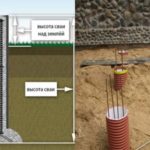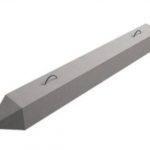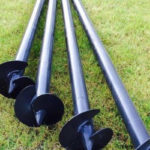Quite often, builders have to erect residential buildings and engineering structures in conditions when the laying of a tape, slab and columnar support system is not possible. Such a situation develops when work has to be done on permafrost, peat bog and in areas where a dense layer of soil lies at a depth of several meters. In such conditions, the only way out is to drill the foundation, followed by driving the piles into the wells.
Creating a well for piles
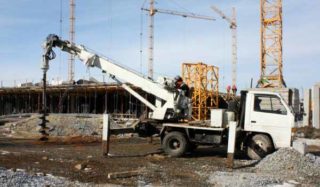
Pile technology is widely used in private and industrial construction. This support system is used when erecting objects on difficult soils, slopes, and the bottom of reservoirs. But the popular method of driving in supports is not always applicable. The resulting vibration provokes ground movements, destruction of nearby buildings, discomfort and poor health among residents of nearby houses.
Drilling under the foundation helps to avoid side effects. The method is a preliminary production of holes, the depth of which varies from 4 to 20 meters. Then piles are pressed or screwed into them. The type of product is determined by factors such as the weight and configuration of the building, the bearing capacity of the soil, and the design strength of the supports.
Pre-drilling for piles provides the following advantages:
- the ability to build on soft and dense soils;
- independence from weather and season;
- reduction of construction time;
- reduction in the volume of earthworks;
- increase in the service life of the ground structure;
- minimal impact on the environment, complete absence of waste;
- increasing the stability of buildings in areas with seismic activity;
- significant reduction in construction estimates.
Due to its peculiarities, drilling wells for piles by hand is rarely used. In most cases, this process is mechanized. The disadvantage of the technology is that a basement cannot be equipped under the building. Therefore, all life support systems are taken to the technical floor, where communications are laid out.
Drilling machines
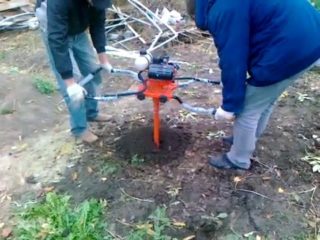
Drilling of piles under the foundation is carried out using special equipment on wheeled and crawler tracks. Equipment rental is not a cheap procedure, but it allows you to do the job quickly and efficiently.
For drilling holes for piles, depending on the working conditions, the following devices are used:
- Hand tools. In different models, the auger is driven by muscular force or a gasoline engine. Designed for drilling screw piles with a blade diameter of up to 30 cm for support systems for light frame structures and fences.
- Portable installations. They are equipment assembled on a metal welded frame with a mechanical drive. They are used in private and small commercial construction for drilling bored piles for low-rise structures with a well depth of up to 4 m and a diameter of up to 40 cm.
- Self-propelled installations. Drilling machines for piles have an unlimited range of applications; they are more often used in industrial and multi-storey residential construction. Depending on the model, the technician is able to drill holes 8-25 m deep with a maximum diameter of 160 cm.
The most successful are complexes that have the ability to drill and immerse supports in them.
Drilling technology
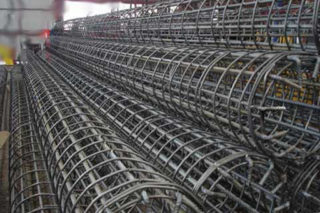
In the process of manufacturing support systems, builders have to deal with different climatic conditions, soil conditions, the presence and characteristics of the infrastructure located nearby. The choice of technology is based on the available data.
Drilling of piles can be carried out using the following technology:
- Bored. It is carried out on especially dense soils in the absence of deep and surface pressure. The main condition for the production of wells is the preservation of the integrity of their walls after the extraction of the auger. The hole is filled with concrete and reinforced. To protect the column from moisture and reagents in wet soils, an external formwork is installed from roll materials or pipes of the appropriate size.
- Printed. This technique provides for the preliminary installation of the casing into the hole. In this case, piles can be drilled simultaneously or with subsequent lowering of the pipes. This technology is in demand when working on unstable soils, as well as in urban conditions of dense buildings and horizontal soil movement. If it is necessary to drill under piles to a considerable depth, a phased connection of sections is carried out using locks, couplings or welding. At high humidity, the cavity is drained and closed from below with a plug. Then the channel is reinforced and filled with concrete. For casing, pipes made of steel, asbestos cement, plastic and polypropylene are used.
- Hammering. The advantage of the method is that the work is carried out with finished products that do not need additional processing. In industrial construction, concrete products with pre-stressed reinforcement are used, which are characterized by high strength and resistance to moisture. In a private household, wooden logs with pointed ends impregnated with an antiseptic and hydrophobic agents can be used. Depending on the conditions, the lowering of the piles is carried out by indentation or percussion.
- Screw. Quite an effective technology that has proven itself well on all types of soils except rocky ones. The holes are made in accordance with the diameter of the barrel of the product or slightly less. After screwing in, a double effect is achieved - lateral compression of the pipe and wide support of the blades on the soil located next to it. The trunk is trimmed to size and filled with concrete.
Each technology has its own pros and cons due to the complexity of pile installation, material costs, strength and durability of the supports. The decision is made after a thorough analysis of all data accompanying the project.
Complications at work and how to solve problems
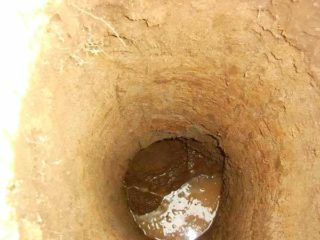
Drilling a pile foundation is a complex task in every respect and requires careful preparation.
In the process of work, the following difficulties may arise:
- Rapid flooding of the well with groundwater - pumping is performed and a lower plug is installed.
- The minimum distance to residential buildings - rammed or screw technology is used.
- The equipment slips and rolls on the working site - a crushed stone pillow is poured over the area of the site and on the access roads;
- The screw pile does not enter the well - reducing the size of the blades, replacing the equipment with a more powerful one.
- In studies on soft ground, no parent rock was found - replacement of driven and rammed piles with screw models with the widest blades.
- The manufacture of a pile cluster leads to the destruction of previously installed supports - wait at least 8 hours before further drilling a well.
With a well-organized study of the soil and terrain, the correct selection of equipment and the organization of work, drilling wells for piles will not cause any complications.

